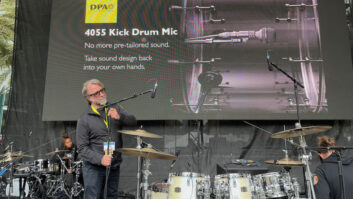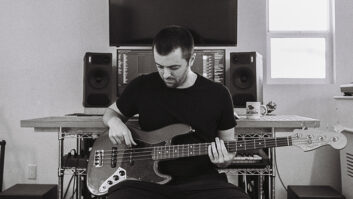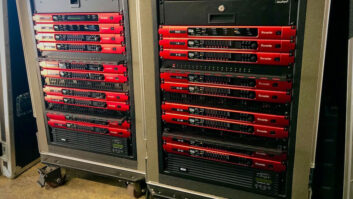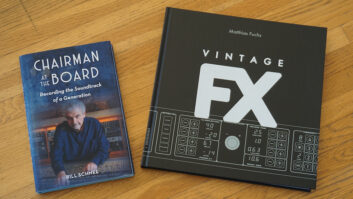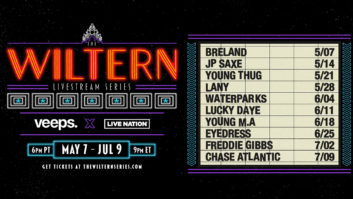The pandemic has shuttered venues around the world, and that has not only left live sound pros without gigs but also the musicians themselves. Stuck at home away from performing, increasing numbers of touring artists who would have been on the road are instead livestreaming performances to connect with fans, give themselves something to do, and in some cases, make a considerable amount of dough through merch sales and virtual tip jars.
Much like performing on stage, the technical aspects of livestreaming are as simple or complicated as the performer wants. While some opt to simply start playing acoustically into their iPhone while streaming, others bring a plethora of gear to the table for added control and creative options.
Cliff Hillis, a solo artist and engineer who’s regularly a part of touring bands behind Patty Smyth and ELO spinoff The Orchestra, has been streaming on Facebook every Sunday at 12:30 p.m. “I use my studio vocal chain,” he said. “It’s a Michael Joly-modded MXL V250 mic to a Golden Age Project Pre-73 mic preamp through my favorite piece of studio equipment ever—an old silver-face 1176 compressor. I run that into a little Allen & Heath ZED-10FX mixer, then I just use a 1/4-inch cable into an IK Multimedia iRig2 that it goes directly into the phone. I have done numerous Facebook Live performances directly into the phone using its mic, but especially for this new project, it’s great to be able to dial in some atmospheric reverb on my vocal, and to be able to plug in my baritone guitar using the Waves GTR plugin and have a more studio-sounding mix of the two.”

While performer/engineer Jono Manson owns The Kitchen Sink studio in Santa Fe, NM, he just sets up his iPhone and plays into it when he livestreams on Facebook every day at 5:30 a.m. “I know that that’s an absurdly early hour, but I’m already up and ready, and a large part of my fan base lives in other time zones, including Europe,” he said, noting that he was on tour in Italy when its pandemic broke out, forcing him to go home and self-quarantine for two weeks.
“All of my gigs have been cancelled, and my recording studio has gone completely dark,” he says. “The only work I’m doing in the studio is mixing and long-distance overdubs, in the absence of any other humans. I, like everyone else who does this for a living, have taken a big hit. I’m not sure how, but we will make it through.”
With that in mind, the daily livestream, dubbed Morning Voice, is providing structure: “Until a couple weeks ago, I had never livestreamed anything. I was resistant to it at first, but now I’m really into it. I wake up every morning excited to do my show; it’s a whole new experience.”

Not everyone livestreaming is pulling out acoustic guitars; Monster Energy Music artist Statik Selektah has been DJing sets four nights a week on Instagram Live in addition to his weekly Thursday night slot on Sirius XM’s Shade 45. Though missing his Technics at the studio, he’s been using his home setup based around a Roland DJ-808, his trusty Shure SM58 mic, a MacBook Pro, and an iRig 2 to connect to his phone.
Software Tech: Livestreaming in the Age of Pandemic
Having livestreamed for ages, he’s built up a considerable online following; one YouTube session with Bun B last spring saw legends Fat Joe, Method Man, Talib Kweli and Big Krit stop by, notching up 50,000 viewers in the process. Nonetheless, livestreaming can be unpredictable when it comes to reaching your audience, he said: “I get frustrated with Instagram/Facebook’s algorithms. My livestream doesn’t even show up on a lot of my followers’ feeds. Some cats with 50,000 followers will have 1,000 people at once, and I see rappers with 8 million followers having 400 people watching! When Facebook made it all about pay-to-play, it messed up the game.”

For Drew Holcomb, namesake of Drew Holcomb and the Neighbors, livestreaming while sheltering from home has simply been about having fun and connecting with audiences since a string of spring festival dates are now cancelled. His nightly Kitchen Covers series finds his wife Ellie and him belting away variously on Instagram, Facebook and YouTube, directly through his phone’s mic. If you’re going for a stripped-down approach, he advised, “Find a good live room with lots of hard surfaces; kitchens work great or any room with hardwood or tile floors.”
Calling himself “a greenhorn livestreamer,” Luke Dowler has been streaming into Facebook Live via an iPhone X connected to a small shotgun mic which he credited with keeping room noise out and adding more fullness to his sound. “Livestreaming’s a little nerve-wracking because you have this ticking ‘watch list’ above judging what you are doing in real-time,” he laughed, but he’s enjoying the process—enough so that he’s already revamping his setup to work with his DSLR camera and OBS Studio, a popular open-source, cross-platform streaming and recording program.

The pandemic shut down North American touring when Cory Marks was just three shows into his “Rednek” tour of Canada with Good Bamford, “so I feel being live anyway I can right now is important,” he said. Performing acoustic sets on Instagram and YouTube via his iPhone, he’s found it technically straightforward, but the absence of an in-person audience was jarring at first: “It’s very different from a live show in regards to the energy, but you can change the vibe by imagining you’re in a smaller club/bar with 300 to 400 people there and give that same energy…. Entertain those people as much as you can, really push your music and merch, and tell them where they can find you and who you are!”
Livestreaming a solo performer is relatively simple, but bring a five-piece rock band into the picture like Sweet Lizzie Project and things get more complicated. In addition to using two cameras—a Sony A7S2 and an iPhone XS—using camlink to connect them to a MacBook Pro, there’s also a Behringer XR18 tablet mixer, Apple’s Logic Pro X, a PreSonus Faderport 16 control surface, OBS Studio and Castr Multi-Streaming software, which allows the band to stream on Facebook and YouTube at the same time. “OBS studio, the streaming software, was the best tool we found to turn our living room into a TV station, since you can control audio, video, banners, pictures, phone calls and add it to your streaming,” said guitarist/engineer Miguel Comas. “It was very simple and took us less than a day to have the set ready to go.”


Canadian rockers Bleeker were supposed to spend the spring touring with AWOLnation, Andrew McMahon and The Beaches all across North America, but instead they’re livestreaming Sundays at 6 p.m. and Thursdays at 8 p.m. Some of their studio gear gets brought into play while streaming, including a beloved Shure SM7B mic, a Universal Audio Apollo Twin interface and various UAD plug-ins. While their fan base is digging it, said Taylor Perkins, “We would much, much rather play live to an audience, but I guess this is the next best thing. We’re trying to learn to like it. My feeling is socials will be over-crowded and overwhelmed with all of this content and ultimately watered down. There’s nothing like a live show.”

Having a certain wariness of livestreaming was a common thread among some of the acts we spoke with, but that view also powers their intent to deliver the goods. While noting “at times it can feel a bit disingenuous,” Atlanta-based Tuk Smith of Tuk Smith and The Restless Hearts is reluctantly embracing the format, aiming to be as professional as possible. “Rehearse and know your songs before you go live,” he advised. “I’ve seen my feed clogged with people trying to wing it and it’s disrespectful to your audience.” While initially he debated on running his live vocals through a vocal chain on an open Pro Tools session, latency concerns ultimately led to a low-tech approach of using a speaker from an early 1970s P.A. he picked up for $150 a few years ago. It’s a work in progress, he laughed: “I ran the vocal through a compression pedal I had laying around and tried to EQ and effect the vocals, but the P.A. still makes it sound like a high-school band practice.” No doubt the sound will be a bit better when the band hits the road this summer opening on the Motley Crue / Def Leppard / Poison stadium tour.

Songwriter Vanessa Silberman found adapting to a livestreaming format (Mondays and Fridays at 2 p.m. PT on Instagram and Facebook) to be a relatively simple jump, having done weekly co-writing sessions via FaceTime, Skype and Google Duo with other musicians for years. For now, given that it’s just her and an acoustic guitar, she’s taking an informal approach just using her MacBook Pro or iPhone to stream, but is planning to slowly incorporate her Sennheiser MD-441 microphone, Universal Audio Apollo interface and various DAWs when appropriate.

Jackie Venson would have spent this spring playing SXSW followed by a tour, but instead she’s livestreaming every night at 9:30 p.m. CT on Facebook. At this point, she’s a veteran of the format, having performed online for the last six years, during which time she’s honed her setup down to just her Les Paul, Kemper amp, Akai Force production system, Pioneer Toraiz SP16 sampling workstation, and a Nektar Pacer MIDI foot controller. “Make sure you understand exactly what goes into streaming and all the possibilities,” she advises newcomers. “There are so many ways to stream and so many different platforms! Oh, and don’t be afraid to fail or try new stuff; of all the places to fail, livestreaming on the internet is the most laid back and forgiving. Let me just put it this way—you ain’t hosting SNL!”



